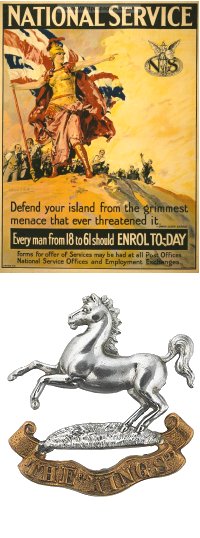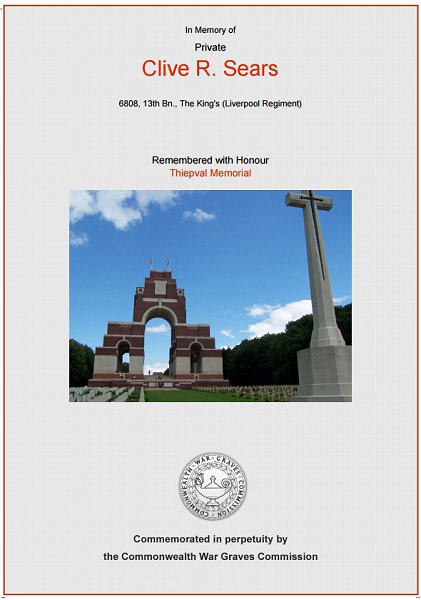yeovil at War
Clive Rewi "Ray" Sears
Killed in action during the Battle of Delville Wood
Clive Rewi Sears, known as Ray, was born on 2 June 1894 in Wellington, New Zealand. He was the youngest of the six children of Frederick William Sears (1860-1912) and Adelaide Charlotte née Baker (1856-1929). His five older siblings were Frederick Joseph "Dill" (1881-1935), Guy Douglas Hackett (1883-1919), Elsie Dora (1885-1967), Stanley Moreton (1889-1969) and Florence Mona (1893-1977) - all having been born in Australia before his parents emigrated to Wellington, New Zealand. Frederick and Adelaide were originally from England; Frederick from Liverpool and Adelaide from Hanwell, Middlesex. As a sidenote, Ray's second name, Rewi, has Maori origins meaning 'brave' or 'courageous'. The family returned to England in 1904, sailing on the SS Suffolk from Bluff, Dunedin, New Zealand to Liverpool. The family settled at 16 Glenmore Crescent, Swansea. In the 1911 census Ray, listed as Rewi Sears, gave his occupation as a trainee engraver.
In late 1915 or early 1916 Ray started working at the Western Gazette in Yeovil as a process engraver, the occupation he gave on his attestation papers. He worked at the Western Gazette for about four months before being called up (His brother Frederick "Dill" was also working at the Western Gazette as a photographer). He gave the address of 88 Hannam Road, Kensington, Liverpool, at the time of his enlistment.
 Ray enlisted in
the army in
April 1916,
joining 13th
(Service)
Battalion, the
King's
(Liverpool
Regiment),
(Liverpool
Scottish), his
Service Number
was 6808. He was
sent to France
in July 1916
with his
regiment.
Ray enlisted in
the army in
April 1916,
joining 13th
(Service)
Battalion, the
King's
(Liverpool
Regiment),
(Liverpool
Scottish), his
Service Number
was 6808. He was
sent to France
in July 1916
with his
regiment.
At this time the 13th (Service) Battalion, the King's (Liverpool Regiment) was part of 9th Brigade in 3rd Division. 3rd Division was a permanently established Regular Army division that was amongst the first to be sent to France at the outbreak of the war as part of the British Expeditionary Force. The 3rd Division served on the Western Front for four years from 1914 to 1918. During this time, it was nicknamed "The Iron Division".
The action that Ray would have been involved in was the Battle of Delville Wood.
On 1 July 1916, supported by a French attack to the south, thirteen divisions of Commonwealth forces launched an offensive on a line from north of Gommecourt to Maricourt. Despite a preliminary bombardment lasting seven days, the German defences were barely touched and the attack met unexpectedly fierce resistance. Losses were catastrophic and with only minimal advances on the southern flank, the initial attack was a failure. In the following weeks, huge resources of manpower and equipment were deployed in an attempt to exploit the modest successes of the first day.
However, the German Army resisted tenaciously and repeated attacks and counter attacks meant a major battle for every village, copse and farmhouse gained. The Battle of Delville Wood, fought between 14 July and 3 September, was an engagement in the 1916 Battle of the Somme in which the 13th (Service) Battalion, the King's (Liverpool Regiment) was deeply involved. Delville Wood is to the north east of the town of Longueval in the département of the Somme in northern France.
After the two weeks of carnage from the commencement of the Somme Offensive, it became clear that a breakthrough of either the Allied or German line was most unlikely and the offensive had evolved to the capture of small prominent towns, woods or features which offered either side tactical advantages from which to direct artillery fire or to launch further attacks.
Delville Wood was one such feature, making it important to German and Allied forces. As part of a large offensive starting on 14 July, General Douglas Haig, Commander of the British Expeditionary Force, intended to secure the British right flank, while the centre advanced to capture the higher lying areas of High Wood in the centre of his line. Delville Wood was a battle to secure this right flank. The battle achieved this objective and is considered a tactical Allied victory. However, it was one of the bloodiest confrontations of the Somme, with both sides incurring large casualties.
Ray was killed in action on 16 August 1916. He was aged just 23.
The Western Gazette, where Ray briefly worked, reported "The news was received with the deepest regret in the “Western Gazette” Offices on Monday of the death in action of Priv. Rewi Sears of the Liverpool Scottish, whose mother resides at Swansea. Private Sears had joined the Army just before Easter, and had been in France for about a month. Always of a bright and cheerful disposition, Private Sears was liked by all with whom he came in contact, and the intimation that he had been killed came as a great shock to his fellow employees at these offices. Much sympathy is felt for Mrs. Sears, who has three other sons serving their King and country, one in France and the other two training “somewhere” in England. Priv. Sears, who was only 23 years of age, was for about four months employed in the process engraving department of the “Western Gazette” Offices."
Ray Sears is remembered on Pier and Face 1D 8B and 8C of the Thiepval Memorial. His name is recorded on the War Memorial in the Borough, albeit incorrectly recorded as Sears, R rather than the more correct Sears, CR.
gallery

Courtesy of Huw
Jones
The Allied Victory Medal awarded to Clive Rewi "Ray" Sears.

The Commonwealth War Graves Commission certificate commemorating Ray Sears.